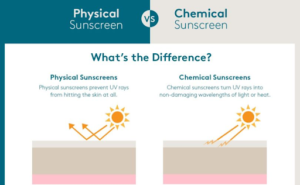Written by: Blaise Geyer PA-C

Summer is still going strong and you need to know that the sunscreen you’re using is doing its job. Is SPF the only thing you need to consider? Unfortunately, not. While it’s important to take into account SPF when choosing your sun protectant, there are two different types of sunscreen lotions and how they work is very different. Sunscreen absorbs the sun and “screens” out the harmful UV rays, while sunblock literally “blocks” the sun’s rays by reflecting them away from the skin. Although both methods are effective, they are not created equal.
First off, What is SPF?
SPF, which stands for Sun Protection Factor, is a measure of how well the sunscreen protects your skin from UVB rays that lead to sunburn, skin damage and skin cancer. The number that follows the SPF provides an idea of the amount of time that you could stay in the sun without burning. For example, if your skin would normally burn after 10 minutes in the sun, applying an SPF 15 sunscreen would allow you to stay in the sun without burning for about 150 minutes (a factor of 15 times longer). This, however, is a rough estimate and depends on skin type, intensity of sunlight and the amount of sunscreen used. Keep in mind that SPF is a measure of protection from amount of UVB exposure and it is not really meant to help you determine duration of exposure. According to the American Academy of Dermatology (AAD), the best practice is to use a minimum of SPF 30 and reapply every 2 hours.
Sunblock (AKA Physical Sunscreen)
Although the term “sunblock” was outlawed by the FDA in 2013 because they thought it gave consumers a false sense of security when spending time outdoors, the active ingredients in physical sunscreens like zinc oxide and titanium dioxide act as a physical barrier between the skin and the sun’s harmful rays. For this reason, while nothing can completely “block” the sun, sunblock is more effective than sunscreen. The active ingredients in sunblock are also safer for the environment and do not negatively affect coral reefs.

Sunscreen (AKA Chemical Sunscreen)
Sunscreen contains chemicals such as avobenzone, octocrylene, homosalate, octisalate, octinoxate, and oxybenzone among others to provide sun protection. Although these do work, the long term effects these chemicals could have on our bodies with consistent use is still unknown. Chemical sunscreens also need to be reapplied more often and take longer to soak into our skin to become effective. That’s why you’ve always heard the rule to wait 15-20 minutes before going outside after applying sunscreen! Because sunscreen does not create a physical protective shield, it does not tend to provide as much protection against many sun-induced conditions like hyperpigmentation and rosacea in comparison to sunblock. Sunscreen is also more likely to elicit an allergic reaction than it’s sister sunblock due to more ingredients and chemicals.
The Takeaway
Since not all sun protectants are created equal, here are the key things to look for when choosing your sunscreen. First, since sunblock is no longer a term you’ll see on products, look at the back label on your chosen sunscreen and search for zinc oxide and/or titanium dioxide. Next, make sure that you are using a sunscreen with SPF 30 or higher. Broad-spectrum, which signifies if it offers protection against UVB and UVA rays, is also an important keyword. Last, make sure that you are applying sunscreen every single day! We experience a lot of UV damage during the time we are in the car and even are hit by UVA rays while inside through windows! Sneaky huh? So whether you’re outside all day or are just walking to and from your car to go to work, do your skin a favor and sunscreen up.
